Text
5 Across February 2019
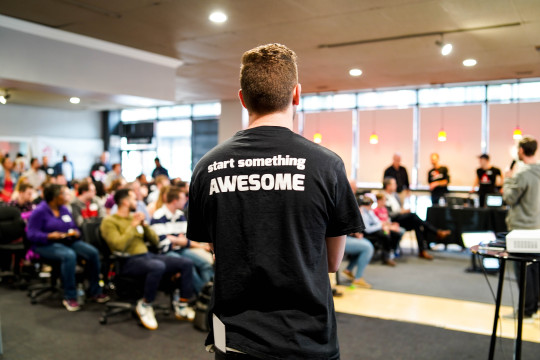
5 Across continued to gain momentum at the standing-room-only February kick off event. This February crowd arrived energized and remained engaged throughout 5 pitches from Lexington’s thriving entrepreneurship community (even two young, dream-filled entrepreneurs in the front row).
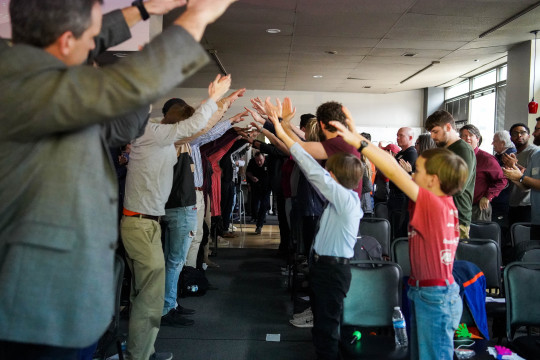
This event made 5 Across history as the crowd met the first “5 Across baby”, Awesome Inc Director Keith McMonn’s first child, named after a crowdsourcing activity at the finals in December. Please join everyone in welcoming “Maxwell Jude”. Keith & Melody & baby
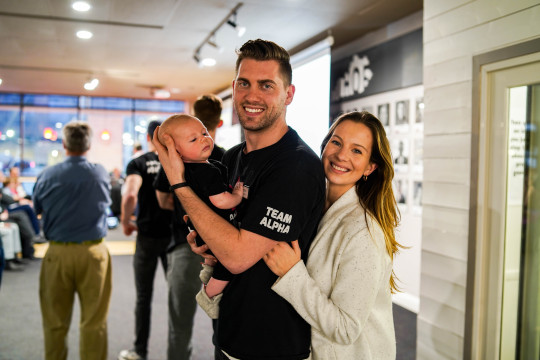
Keith thanked the generous sponsors:
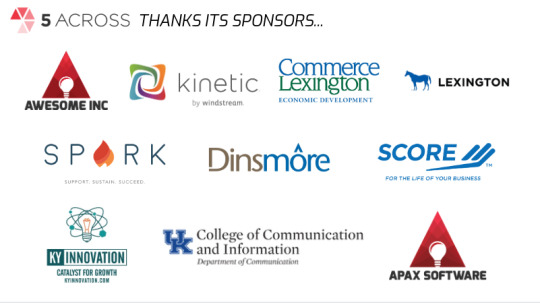
Then the room quieted down as the contestants prepared to jump into their stringently-timed 5 minute opportunity to impress the listeners but most importantly, the panel of wildly talented judges.
1. Michael Hartman from FrogDice
2. Brian Evans from BTwebgroup.com
3. Aldona Valicenti from LFUCG
4. David Goodnight from Bluegrass Angels
And so, the pitches began!
In order of appearance:
1. EZ Turn : EZTurn: With the tenacity and disciplined he learned from his time as an NFL player, Chase Minnifield has spent the last years building a growing labor company. He began looking for an app that would assist in the communication and time crunch issues of the “Student Housing Turn” and when he couldn’t find one, he decided to create his own. Minnifield brought along Lincoln Ogata and together, they built EZ Turn: “an easy to use streamlined turn tool that boosts efficiency, saves money, documents turn and provides communication along with transparency from the site to the corporate offices.”
2. Penge : Brittany Joiner has a vision - a vision to make personal finance socially acceptable to discuss. As she came out of college and hit the job force, she felt under-prepared, overwhelmed, and struggling to figure out finances on her own. She created spreadsheets and hundereds of Google searches, but she couldn’t find a reliable source that made things easy enough to be practical. Instead, she turned to her friends - and that’s where her vision was born. What if there was a platform you can use to crowdsource information from your community to help you figure out your financial journey, hold you accountable, and encourage you along the way?
3. Kare Mobile : It’s no secret that going to the dentist is a hassle. Finding one you like, with availability, takes your insurance, doesn’t requires hours taken off work… Kare is here to solve those problems. Kare connects patients to dentists close to them, with availability, and that take their insurance. But beyond that, they’ve built the first mobile-dentists office that will come directly to the comfort of your own home or office to service your dental needs! They offer full-service connection to any dental problems.
4. Vet’s Day Off : Veterinarians are some of the most overworked and overwhelmed practitioners in the US. They notoriously work 7 days a week and suffer from exhaustion and compassion overload have one of the nation’s highest percentages of suicide population -- Vet Data takes these issues seriously and is looking to become the “Airbnb of the vet industry.” They want to utilize the already-standard “relief veterinarian” idea and quickly and easily connect relief vets with vets who desperate need a break. They will help vest provide quality services while also maintaining a healthy work-life balance.
5. Toggle Health : Dubbed “the Roku of the operating room”, Toggle Health is a healthcare technology company with the goal of transforming the operating room. In today’s ORs, if a surgeon needs to adjust their reference photo on their monitor, they have to leave the patient, manually adjust the monitor with the mouse, and leave the room to re-scrub back in. It’s time-consuming, costly, and puts patients at risk. Toggle is combating this broken system by connecting surgeons to their digital case data in the OR using a sterile, wireless controller while our enabling software provides a smart-tv like user experience, allowing surgeons to easily toggle between their desired applications and devices.
Once all 5 companies had presented, the judges left the room to privately decide on the results while the audience members took time to congratulate the contestants on successfully completing their pitches.
Winner of the AwesomeVote app winner (and winner of $50 from Kinetic): Toggle Health!
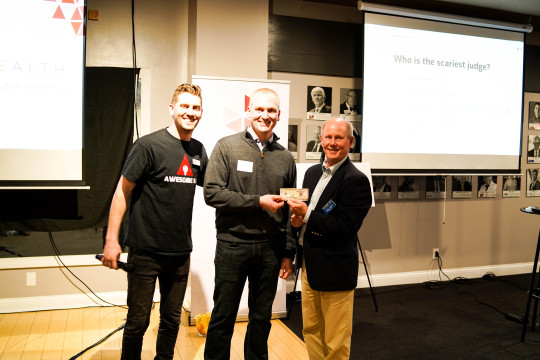
And most importantly, winner of the February 2019 5 Across was
KARE MOBILE!
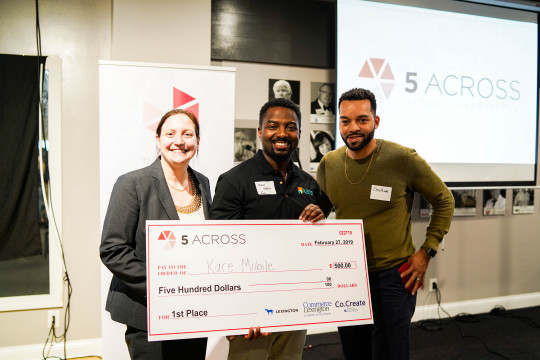
The judges cited the company’s bright future in multiple markets - under-served populations, prisons, schools - as their final decision-making factor.
Congrats to Kare Mobile - your startup community can’t wait to see you succeed!
See you all in April!
1 note
·
View note
Text
5 Across Finals 2018
The most competitive and innovative ideas of the year got a chance to compete once more on December 5th, at what is now known as the largest 5 Across event in history. With the spirit of the holidays in the air, it was clear that this 5 Across would be unlike any other.

200 people excitedly shuffled into the historic Kentucky Theatre— some regulars, and others not knowing exactly what awaits them.
As the chatter died down and everyone took a seat, the winners from each 2018 5 Across event prepared to give their final pitch to compete for $4000.
First up were February winners Pascal Tags, who created an alternative solution for businesses facing unorganized inventory, overstocking, and out-of-stocking. The company’s now patented, battery-free tags give business owners a cheaper solution to tracking items. Since winning 2017 Startup Weekend Louisville, this company had a one-of-a-kind idea from the start.
Next was Chez, a company that promises a gourmet meal right in the comfort of your own home. Users can down the Chez app and hire a chef to cook a meal at home. While the service is aiming for larger, denser cities, it is on the way to transforming what we think of as “eating in.”
Wild Dog Physics gives cancer patients a cost-efficient and timely treatment option opposed to traditional radiation therapy. To bypass the complicated nature of many radiation treatments, Wild Dog Physics has developed hardware and software that combines all the necessary pieces for cancer treatment into one lightweight, compliant device.
Next was April winner Moolathon, an app that monetizes a user’s fitness for a cause through virtual 5Ks, individual campaigns, and gyms that are similar to Pokemon gyms, where users can compete and interact with other fitness enthusiasts, all while supporting the charity of their choice.
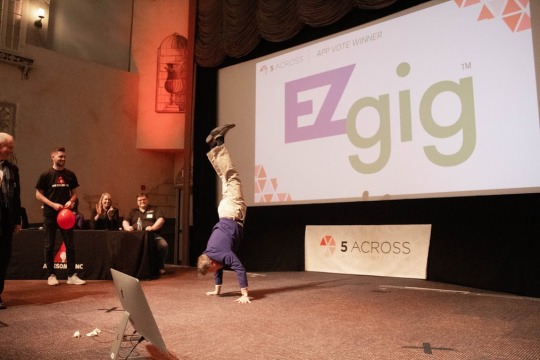
The last pitch of the night went to EZGig, a company that is the Lyft or Uber of the workforce. Employees can sign up on the EZGig app, upload a resume, and get hired for events or temporary positions. EZGig users will then get rated after a job is complete, which will give them an upperhand for future jobs.
Once the pitches were complete and the judges went to deliberate, attendees got a chance to mull over seeing Kentucky’s most promising entrepreneurs.
As the judges made their reemerged and a decision was made, it was time to announce the winner of the 2018 5 Across Finals.
An eager drumroll reverberated through the audience as EZGig was announced the AwesomeVote app winner.
A slightly louder drumroll from the audience echoed throughout the theater and Moolathon was announced the second place winner of $1000.
Finally the moment everyone had waited all year for was here, and we’re not talking Christmas morning. With the help of boisterous cheers and the clanging of noisemakers throughout the theater, Pascal Tags was officially announced the winner of the 5 Across Finals!
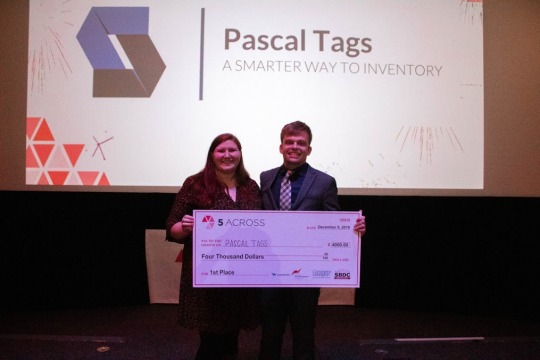
Join us February where we begin a brand new year of discovering exhilarating, innovative startups!
0 notes
Text
5 Across August 2018
As summer is coming to an end and school is back in session, Lexington entrepreneurs are showing no signs of slowing down. Noisemakers, delicious food, and the anticipated audience chatter could only mean one thing- another 5 Across was about to commence. The judges were ushered in with the help of an energetic audience and the pitches were ready to begin.

First up was Eddiction, an online community forum that allows for alternative advertising and sets itself apart from traditional online marketing. By gearing advertisements to niche communities, Eddiction promises to have a stronger and long-lasting impact impact on audiences. Whether it be politics or sports, advertisers will be able to give the online public more relevant advertising, as well as keep track of analytics.
Next was a fresh take on commonly used collaborative software. PlanStreet aims to fuse project management and team collaboration together in a new way. Using the combination of real-time project planning, individual and team goals, scheduling, and budget management, users are more inclined to complete tasks efficiently and on time.
The third pitch was a crowdfunding fitness app that presents charities and teams an opportunity to raise money for their own causes. The Moolathon app is able to monetize on user’s fitness for a cause. Through virtual 5Ks, individual campaigns, and easily identifiable gyms (“coined as Moolathon gyms”), users can interact with other fitness lovers while supporting their charity of choice.
The next pitchwas Lucille 1, a cryptocurrency and mining investment company. They guarantee to provide the hardware and know-how to potential cryptocurrency investors that are interested, but may not have access to the overhead required in beginning mining cryptocurrency.
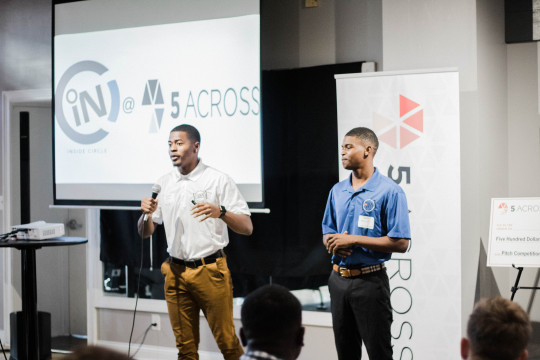
The last pitch tackled a new way to consume sports-related news. Inside Circle is a fresh sports publication that creates and shared original content. By recruiting their audience through college internships, events, and merchandise, Inside Circle can effectively tackle the competition. Inside Circle allows athletes and non-athletes alike to chat and discuss the latest sports news instantly.
As the pitches came to a close, the judges migrated into the conference room where a decision had to be made as to who would become the August 5 Across champion. The vast variety of ideas pulsed through the room as the audience waited, antsy to hear the verdict.
When the judges emerged, an audience drumroll filled the room and Inside Circle Sports was recognized as the AwesomeVote app winner.
With a louder drumroll and cheering from the audience, Moolathon was announced the August 5 Across winner!
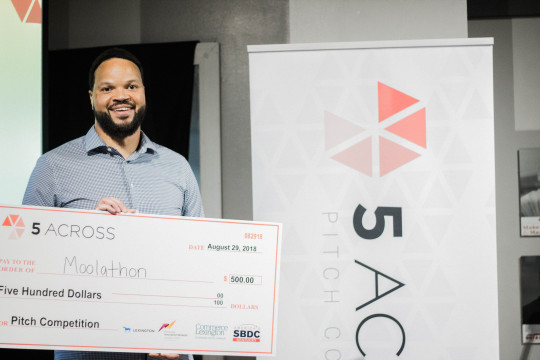
Join us at the next 5 Across in October! The noisemakers will be just as loud, the food just as delicious, and the pitches will be just as innovative.
0 notes
Text
5 Across April 2018
The birds were chirping, the bees were buzzing, and Kentucky’s best entrepreneurs have come together to compete for the title of April 2018 5 Across champion! Our second 5 Across of 2018 was jam-packed with noisemakers, a surprise appearance from Kentucky’s Lt. Governor, and of course, the areas best up-and-coming entrepreneurs.

First up was Zid Zid, a language learning platform for young children. Wife and husband duo, Julie Klear and Moulay Essakalli, created this app to reinvent the way in which children can learn new languages. According to their website, the app uses “the importance of play and positive human interactions” in order to stimulate kids in a way that is long lasting.
Next was Whoo, a new app that helps users identify visitors. By replacing the traditional doorbell, Whoo gives users the opportunity to see guests before and potentially keep them safe from unwanted strangers. With time, Whoo’s technology is able to recognize and remember frequent visitors in order to inform the user more appropriately of its visitors.
While on a trip to South Carolina, Nate Antetomaso realized that most traveling sports fans get to their destination without a set itinerary and are left with an unfulfilling trip. AwayGame aims to change just that. Using the traveler’s interests, hobbies, events attended, and more, AwayGame is able to curate a solid, specific list of entertainment for users to ensure that they never have a wasted vacation again.
The next company introduced a new, interactive way for users to be charitable! With Cherry, users can donate and support charities, while being rewarded for menial tasks, such as simply logging into the app.
Right before the last pitch of the night, the audience was met with a very special guest— Lt. Governor Jenean M. Hampton. Having a state official here support for entrepreneurs made this 5 Across all the more special.
The final business of the night introduced a new meaning to eating in. With the Chez app, users can hire a chef to cook a meal in the comfort of their own home. The service is aiming for larger cities and is bound to change the way most people see food delivery.
“Kyle and I conceived the idea for Chez during the summer of 2017 as part of a project for our MBA at Bellarmine,” said co-owner Russ Davenport. “The project was for our Marketing and Finance classes, where we were tasked with coming up with a new venture that was "blue ocean". Kyle and I both have experience in the hospitality industry and we thought that this idea had a chance of working.”
With the final pitch complete, the judges convened to decide who would be the 5 Across champion. Anxious chatter filled the room while the judges deliberated. Although all teams proved themselves worthy 5 Across contestants, only one could be named the winner.
As a hush fell over the room as the judges emerged, and the crowd knew it was almost time for the big announcement, but first the awesomevote app winner was to be announced. With a drumroll, Zid Zid was announced the the audience favorite and winner of $50.
Next up was the big reveal, and with the help of a massive roar from the audience, Chez was announced the winner of the April 2018 5 Across!
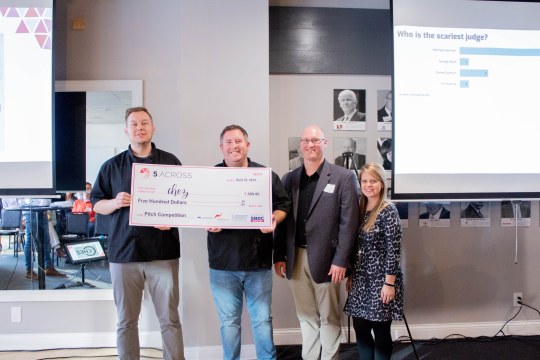
“We had pretty low expectations going into the event, as we had just come off of Idea State U where we failed to place in the top 4,” said Davenport. “We had a short time to adjust our pitch to the short 5 minutes that you are given at 5 Across, which was another challenge. The one thing that we were excited about was that we thought the judges at 5 Across were true entrepreneurs and we thought that we could get our message across to them.”
Join us for the June 5 Across at Alltech’s Shrewsbury Hall that’s bound to be bigger and better!
0 notes
Text
5 Across Feb 2018
Awesome Inc decided to ring in the New Year the only way we know how— by bringing the fun. Although the room was flipped 90 degrees, the familiar electricity filled the air. With noisemakers in place and excitement in the air, there was no mistake that the first 5 Across of 2018 was about to take place.
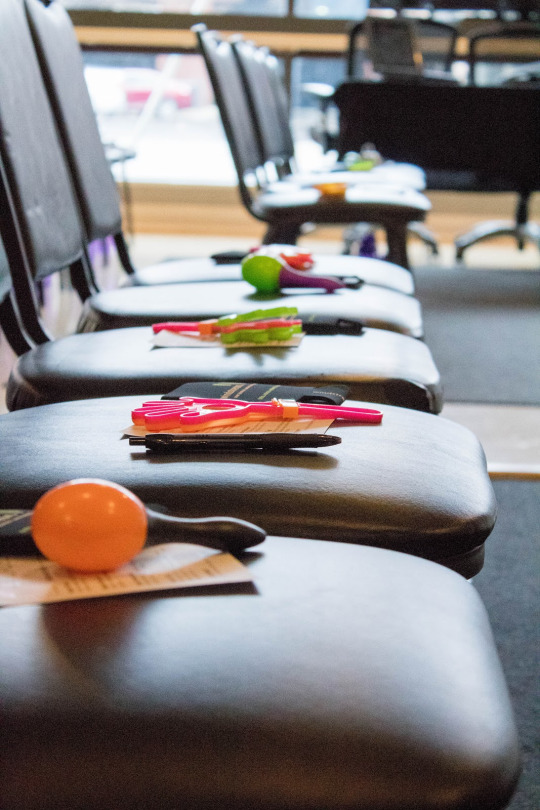
First up was a new way to aid stroke victims and make their rehabilitation more accessible. HandPrint is a 3D-printed, customizable glove that is said to be the first of its kind. Most gloves don’t have the flexibility in personal customization as HandPrint’s product, which sets them apart from their competition.
Next was iReportSource, an efficient way for companies to gather safety information for their employees. According to their website, iReportSource promises to “Enable and equip any employee to report hazards, safety suggestions, near misses, and even incident reports from the field to reduce total time from incident to resolution.” The application takes the heavy load that comes with employee paperwork, such as accident and progress reports, and puts all the information into one handy app.
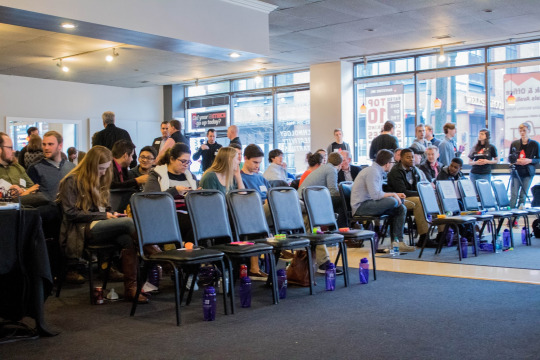
With a background in gymnastics, Madison Hartung knows a thing or two about how complicated scheduling for gyms can be. Using her history and experience with gyms, Smart Rotation was born after winning second place winner at the 2017 Startup Weekend Lex. Smart Rotation solves the issue of overbooked or underused gyms, due to lack of updated scheduling. This software creates automated resource scheduling to ensure gym space scheduling is always up-to-date.
Pascal Tags is introducing an alternative solution for businesses facing headache-inducing issues, such as inventory distortion, overstocking, and out-of-stocking. Their battery-free tags help businesses keep track of items, while being cheaper than commonly used security tags, such as RFID and barcodes. Winning 2017 Startup Weekend Louisville gave this company a head start in finding a solution to this problem.
“The idea of a new “passive tag” came about because I would always lose my items or forget them before I would leave,” said co-founder Brandon Young. “I noticed that a lot of companies and inventory tags (bluetooth tags) only focus on losing items versus forgetting.”
The publicity from their Startup Weekend win allowed Pascal Tags to discover various new markets including businesses, museums, car dealerships, and more. They have a working prototype that is currently patent pending.
The last company was an inventive way for young high school athletes get a head start in their college careers. RecruitMeKY paves the path for high school students looking for the most feasible way to gain recognition in their sport, while also obtaining athletic scholarships. This recruiting service sends out the students stats to college coaches, while also publishing their information on the RecruitMeKY website. From archery, wrestling and football, this company offers students a chance to make finding a school a homerun.
As the last pitch wrapped up and the judges went into their deliberation, the audience chattered with excitement. When the judges re-emerged, the winner of the fan favorite using the 5 Across Vote app was announced. With the help of an audience drumroll, RecruitMeKY was announced as the fan favorites and the winners of $50, thanks to our sponsor SCORE.
The audience quickly hushed in anticipation of the first 5 Across winner of 2018. With an even larger audience drumroll, Pascal Tags walked away the champions.
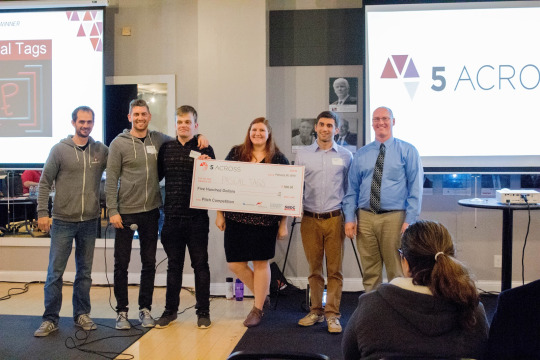
“Our next step is to continually test our prototypes, continue to receive letter of intents, and continue to gain market research.” said Young. “All of the current industries want to buy our product right now, but we want to make sure the market size and barrier to entry is very minimal.”
Join us April 25 for the next 5 Across!
0 notes
Text
5 Across Finals
From February to October 2017, 20 of Lexington’s best startups competed, and some succeeded, in becoming 5 Across champions. As the year has come to a close, each winning team of 2017 came back for the ultimate showdown— the 5 Across Finals. This time around, the noisemakers were louder, the anticipation came to a boil and, with the chance to win $4000, the stakes were higher than ever.

Since 2010, Awesome Inc has been home to one of Lexington’s most innovative events. Coined as “the Shark Tank of Lexington,” 5 Across allows startups to pitch their ideas, while networking with like-minded members of the entrepreneurial community. The finals are a definitive statement of the most successful startups in Lexington. The four returning champs were: Smart Student Storage, Sum180, WelcomeHome, Enepret, and Billbusters.
First up was Smart Student Storage, a moving business aimed towards college students. Instead of students juggling final exams and prepping for their end-of-the-semester move, Smart Student Storage will pick up the student’s belongings and place them in a storage unit until the beginning of the next semester.
Second was October’s winner Sum180. The company allows users to set up a financial plan that suits their next big financial decision. Co-founder and CEO Carla Dearing describes the company with five characteristics:
“1) Meet people where they are in their financial journey; 2) Respect them and understand that they are capable of moving forward if they are provided with simple step-by- step advice; 3) Be unbiased; 4) Not try to give them a finance degree but rather point them toward how-to’s that will help them solve an immediate concern; and 5) Have no ‘guy in the grey suit’ talking down to them.”
Next up was February 5 Across Winner, WelcomeHome. Founded by Kai Zhang, WelcomeHome connects internationals with desirable housing before arriving in the U.S. and helps qualified landlords and rental agencies identify long term reliable international tenants.
“Although our primary customers are internationals, we can also connect domestic customers with desirable housing if they need to move to other places,” said Zhang.

August 5 Across winner Chase Kempinski took the stage next and updated the crowd on his company, Enepret. The business provides a substitute for common oils found in medicine, cosmetics and other personal care products, such as shark liver oil and olive oil.
The last returning champion was BillBusters, who won the June event. Co-founder Tyler Menke helped create this company after they realized that him and his colleagues were being overcharged on many of their cable and internet bills. With this, they created BillBusters to give users an easy way to compare cable company prices. Additionally, the team offers to be the middleman in negotiating their customers cable and internet bills.
As the pitches wrapped up, the question remained: Who would be the grand champion of 5 Across 2017? Each company had already proved their worth in the world of startups, but it was up to the judges to decide the ultimate winner. After a brief break for the judges to deliberate, the results were in.
Before the winners were announced, the fresh new logo for 5 Across was revealed and, based on the audiences reaction, very well received.

First up, the winner of the awesomevote app was the one and only Chase Kempinski of Enepret, who was awarded $50.
Second place and a prize of $1000 went to Carla Hearing of Sum180.
And last but not least, the grand prize winner of the 5 Across finals went to Kai Zhang of WelcomeHome. The judges had positive feedback for Zhang and by the look on his face, it was clear that he was thrilled.
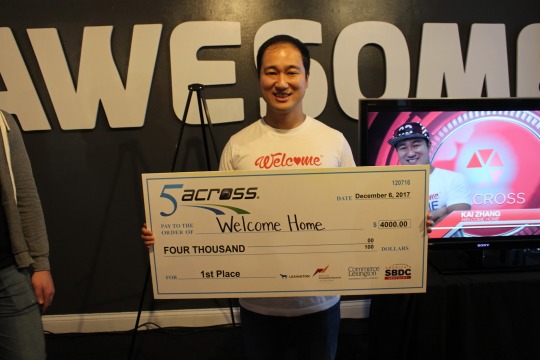
“I received sufficient and valuable coaching from Awesome Inc before the pitch and learned a lot from other teams through the networking events as well,” said Zhang. “The $4000 prize money we won will definitely contribute to expanding our business.”
Join us next February for the kickoff of 2018 5 Across!
0 notes
Text
How to sell your product in 10 words & 30 seconds
With nearly three decades of marketing experience under his belt, Eddie Woodruff knows a thing or two about compelling advertising. He received his communications degree from Western Kentucky University and went on to create his own ad agency from 1985 to 1999. Seeking a new challenge, his hard work led him to join Forcht Bank in 2007 as their Chief Marketing and Communications Officer and eventually became a board director in 2014.
The Forcht Group is a conglomerate of companies that includes retail, broadcasting and banking. Based out of Corbin and Lexington, Kentucky, the multi-million dollar group has brought over 2,000 jobs to south and central Kentucky, all while effectively marketing their message.
Community banking has always been a vital part of any community, helping local businesses thrive, providing great customer service and being more economically sound. As opposed to bigger banks, community banks have one goal in mind— to help the little guy. That’s why Forcht Bank is such a staple in Kentucky, but none of that can be done without efficient local advertising. At Awesome Inc, Woodruff will highlight his vital strategies needed for any company seeking successful marketing schemes: product, pricing, sales, message, creative, channel and budget.
A business’ product and channel strategies should be able to establish what the product is, offer a unique selling proposition and seek the best way to advertise that product. Although there are other forms of channeling your product, such as PR and traditional media, social media has made advertising easier than ever before.
Regardless of your marketing channel, an effective advertisement should be able to offer a product in 10 words and 30 seconds. No matter what phase your business is at, Woodruff says online advertisements have made this job easier.
“[You’re] better able to target people most likely to purchase than through traditional media,” Woodruff says.
Through sales strategies, you need to establish who your audience is. In Woodruff’s case, his broad audience would be adults or local business owners in Kentucky. This ties into your message and creative strategies.
With decades of running his own business and being a part of one of Kentucky’s largest companies, Eddie Woodruff is the marketing expert young businesses need to thrive. Join us at Awesome Inc on October 11th from 12 to 1:30 p.m. Reservations are free, but seating is limited so be sure to RSVP as soon as possible. Lunch and refreshments will be served.
0 notes
Text
Another Awesome Inc Bootcamp has Begun!
At 8 a.m., Awesome Inc bootcampers prepare to have a day filled with algorithm warmups, lectures, free time to work on projects, all while fueling themselves with endless amounts of Doublestuf Oreos. The seemingly fast-paced lectures and projects are jam-packed with rich lessons each student will hold close as they prepare to market themselves to the vast world of software development. This bootcamp is not simply a course that gives brief, vague lessons in coding, it is a course that will pave the future of participants, whose career backgrounds might come as a surprise to most.
Josh Stewart was a college lacrosse coach and received an M.A. in Higher Education at Messiah College in Mechanicsburg, Pennsylvania. College athletics caused him to move frequently and he realized that in order to support his family better, he needed to shift careers. At 28, he decided to check out Awesome Inc’s Web Developer Bootcamp.
“How can I have a better work/life balance, how can I make more money, and how can I stay put? I solved all three of those problems at once,” said Stewart.
Typically, Stewart is quick to picking new things up, so it came as a surprise to realize that coding language would be more challenging than he anticipated. But with hard work and the right attitude, his finished projects made it all worth it. He is now equipped with the knowledge that is guaranteed to guide him into his new career path. It’s the last week of classes and he has already had three job interviews. Simply put and in his own words, Awesome Inc has surpassed his expectations.
Brandon Spencer spent over a decade in restaurant management. With some high school coding experience and a B.A. in History under his belt, his interest in web development came at the forefront after learning of Awesome Inc’s bootcamp one year ago. His itch for wanting to learn more led him to the three month course that has been met with a rewarding and life-enhancing experience.
“It’s surprising to see how far you’ve come, but also an understanding that there are a lot of things you still don’t know,” said Spencer. “We’re pretty well-equipped to be able to figure it out, which I think was one of the goals from day one.”
For future bootcampers, Spencer has a few vital pieces of advice: get some sleep, remember that everyone feels defeated at times, and no matter what “keep pushing forward.”
The three month course has been an uphill battle for some bootcampers, but despite the frustration that comes with any new task, the payoff is well worth it.
“12 weeks ago, I couldn’t write a line of code,” Stewart said. “It seems like we have all the tools and support system from Awesome Inc to get a job.”
Education and career backgrounds are not a determining factor in who can become the future of software development. What does determine it? Hard work, dedication, persistence and the strive to grow as an individual.
0 notes
Text
Awesome Inc Summer Retreat 2017
What happens when you get 40+ successful entrepreneurs in the same cabin for a weekend? Ego clashes? Best practices? Inspiring stories?
With each individual holding conflicting expectations of the Fellowship summer retreat, Awesome Inc co-founder, Brian Raney, and Fellowship Director, Keith McMunn, led the first session to establish a culture for the retreat. Core values have preserved the unique and open culture at Awesome Inc throughout the years, so entrepreneurs teamed up with investors and friends of the Fellowship to pitch values that they believed would provide a unique and open culture for the retreat. The group agreed on several values that created a space for vulnerability, empathy, inclusiveness, and getting out of your comfort zone.
The next session was led by management expert and Fellowship mentor Drew Sutton, who gave a very informative presentation about the characteristics and challenges faced by great leaders. Drew’s presentation was filled with historical and comic book references that kept everyone laughing, while extremely engaged. He mentioned that a good leader must keep his team prepared for the “fog of war,” explaining that it’s his job as a leader to inform his employees of the guiding principles that will help them make decisions on behalf of the company in the fog. Drew shared that he keeps all the principles and values that he expects from his employees written down and presents them to every new hire.
After bonding through both sessions, Brian Raney regained the room’s attention and laid down the rules for a game that was played throughout the next two days. The game, affectionately called “murder,” was started with Brian secretly selecting three murderers among the group. The three assassins were tasked to ‘kill’ the townspeople, and the group would vote on who they thought was committing each crime.
The “smoothest-kill-of-the-weekend” was made by Ford from Cloverleaf. Ford scaled the side of the cabin, jumped onto the balcony, took out everyone in the hot tub, and walked inside before anyone noticed. The only witness to the crime was the cabin groundskeeper, who saw Ford dramatically leap from the balcony during his escape. Unfortunately, he was unable to provide any incriminating evidence. Other murders were not as smooth and resulted in mass shootouts, and hitmen getting caught after single shots.
In addition to the fun icebreakers, attendees bonded while tubing down the Little River in Gatlinburg and hiking to a beautiful waterfall during a summer rain shower. Cloverleaf held the last session of the first day. The founders had collected data from attendees including their Myers Briggs, DiSC, and workplace culture preferences and used the results of the data to pair harmonious groups. After discussing their effectiveness as a team, they had to put it into practice by completing the egg drop challenge with just post-its, straws, and plastic cutlery. Each team dropped their egg without it breaking, which may be evidence of Cloverleaf’s software successfully brings effective teams together.
The next day, sessions leaned on the technical side with a representative from Dinsmore & Shohl, LLP sharing how to get the best service from a law firm. The group learned that entrepreneurs often seek help from an attorney too late into the process, so it is best to begin the relationship with a practice while building your company. This allows you to obtain more negotiable price points and to connect with the right type of firm for your business.
Following the Dinsmore session, Elizabeth Rounsavall, a Venture Capitalist, shared a wealth of information about investment opportunities for startups. Founders in the room opened up by sharing their experiences with boards and investors. As they discussed best practices, Elizabeth gave them the Venture Capitalist’s point of view on what a Kentucky investor expects compared to what an out of state investor will take an interest in.
The final session was led by friends of Awesome Inc, Bryce and Elzaba Anderson. They shared their stories of trials in entrepreneurship, inspiring the group to think about their “why” and “good.” Bryce spoke about his journey with Vinaigrette Salad Kitchen and the failures he faced while trying to carry out his “why” of working with Kentucky farmers. Bryce’s story moved the group to think about the principles and values that keep them afloat while trying to fulfill their own “why.”
Elzaba encouraged everyone to breakup and discuss how to find value and approval for their sense of good. The circle was asked to reflect on their lifestyle, which segued perfectly into a moving speech, aka “The Thing,” from Brian Raney at the close of the retreat. Brian spoke about his “why” when he created Awesome Inc and his own moments of doubt and the thing that reminded him to carry on with his vision.
The summer retreat was filled with great opportunities for learning, networking and reflecting. In typical Awesome Inc fashion, we made time for fun and games of murder in between. The greatest takeaway are the bonds that were established between motivated startups. All the while, the value of surrounding yourself with people who are passionate about your work is priceless.
youtube
0 notes
Text
5 Across August 2017
A few dozen seats filled with noisemakers, nametags and the chatter of excitement can mean only one thing- another 5 Across is about to happen. While children, college students and adults alike shuffled into Awesome Inc, there was an overwhelming sense of promise, inspiration and a hint nervousness.

Sure, everyone had their vague descriptions of each business on a small slip of paper, but seeing the entrepreneurs in action would show how great these businesses truly are. The murmurs quickly quieted as each entrepreneur prepared to make their pitches in front of the 100+ audience.
First up was Enepret, a business that provides a substitute for common oils found in medicine, cosmetics and other personal care products, such as shark liver oil and olive oil. With this, co-founder Chase Kempinski and his colleagues designed a new type of oil that serves the same purpose, but can be geared toward a variety of markets.
“We were always interested in the applications of the oils we’ve engineered our organisms to produce,” Kempinski said. “I love science, but I also believe it should serve a purpose.”
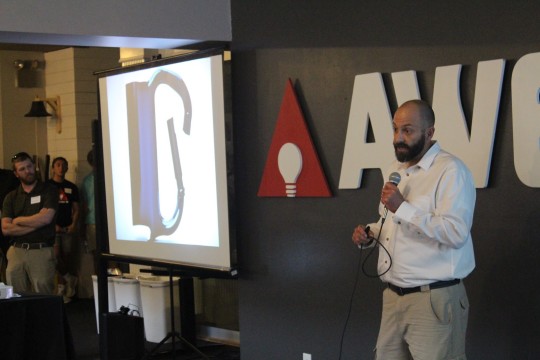
Next was BinerWorks, a duo who aim to take an ordinary biner and turn them into multi-faceted, unique designs. The first variation Kelly Moore and Matt Able presented was a combination of a biner and lighter. The second was a safety biner, which contains a blade among other tools to help in case of an emergency.
Introducing a substitute to traditional charcoal were high schoolers of Bio-Char, Sam Newman and Andrew Gazzaroli. Bio-Char is made of paper and sawdust compacted into charcoal-like bricks and allows proficient grillers to maintain the smoky taste they love dearly, without the carbon monoxide. With their presence, mannerisms, and confidence, you would think these teenagers were seasoned entrepreneurs.
The second half of the event brought John Mahoney, the founder of Moby. Using a mobile device, Moby helps to eliminate identity fraud and allows businesses to properly identify anyone, anytime.
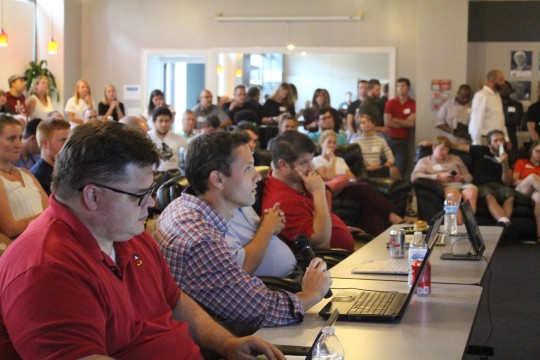
To cap off the night was Hummingbird Nano, who presented a microfluidic chip that combines the flexibility of 3D printing with the efficiency of injection molding. Co-founder Scott Stephens describes it as, “a component used in chemical analysis systems for detection in everything from drug discovery to forensics to disease diagnostics.”
Once each team wrapped up, the judges migrated into the conference room where a decision had to be made. The vast variety of ideas pulsed through the room as the audience waited, antsy to hear the verdict.
As the judges emerged, Bio-Char was brought to forefront only to not be announced the winner. While they won crowd favorite through the awesomevote app, the two teenagers received personal donations from each judge for the first time ever in 5 Across history, which encouraged them to continue on their entrepreneurial journey.
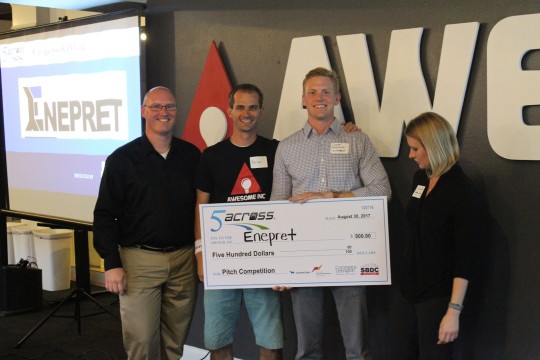
At long last, after an inspiring night full of fresh ideas, Enepret walked away with the $500 grand prize and declared the winner of 5 Across August 2017.
“The next few months are important for us and I hope I’ll have good things to report on when I come back to 5 Across in December!”
Join us next time on October 25 for another inventive and exhilarating event.
0 notes
Text
Bill Burke: Revolutionizing the Energy Industry With Real Time Data
Bill knew from a young age that he wanted to be an engineer but after graduating with a mechanical engineering degree from UK and working for Lexmark, he wasn't so sure if a corporate setting was for him. Bill moved to California in 2003 to work for a startup, while his wife went to school at Berkeley. He began to fall in love with the startup community there but after ten months at his new startup job, the company was sold and he, too, applied to and was accepted to a Berkeley Phd program.
During his time in school, he worked with the Berkeley Energy Commission and continued immersing himself in the energy industry. After graduation he joined the GE energy management team. His work involved connecting appliances to the internet to collect data which would later inspire his own startup.
After ten years of working in the energy industry, Bill came to the same realization that made him leave Lexington for California in the first place. He didn’t like working for other people. “I hated working at GE. The work was great. The people were great. The problem was me.” Bill decided to give the startup world another go by creating his own company. After a first attempt at a SaaS platform called Lingua, anattempt to recreate the engineering software MatLab in the cloud, Bill decided to resort back to his roots in energy when he started Virtual Peaker.
“I hated working at GE. The work was great. The people were great. The problem was me.”
Virtual Peaker is a SaaS that connects home owners to the logistics of their home systems (like their hot water heaters) and recommends settings that would save them money. The information can also help the energy companies have a more predictable supply. The problem with the current model of the energy business is that energy is generated as needed, and demand can be unpredictable.. If companies are able to grasp in real time what the needs of the people are, then it's much easier to generate energy proactively versus the reactive system that’s in place now. Virtual Peaker providers a platform creating a win-win scenario for both users and providers.
Bill has seen a lot of growth with his platform but still states the difficulties of being an entrepreneur with a family. He says, “It’s really scary being a startup founder with kids. Spending time with my family makes me a better person and clears my mind.” He asserts that his family is what drives him to work hard and enables him to do what he loves. He gives a lot of praise to his wife by saying, “I can’t possibly do this without my wife. She’s supported me all along the way. Without her, I couldn’t be here doing this.”
He looks to young entrepreneurs saying he wishes there was an impactful one-liner that he could give them as though starting a business had a simple code to success, but it's a long process that he explains can be lonely and really hard. You’ll absolutely want to quit, he states, “That’s why there are lots of wantrepreneurs and not many entrepreneurs.” He think it’s important to remember that even overnight successes have about 5 years of work that went in on the back end.
“That’s why there are lots of wantrepreneurs and not many entrepreneurs.”
Bill lives in Louisville, KY with his wife Krista and 3 kids, Molly, Penelope and Sydney. He spends most of his free time with his family. Bill runs trails an impressive 6 days a week in order to get time to himself.
Learn more about how Virtual Peaker is increasing the IQ of the power grid by clicking here.
0 notes
Text
What do the Coal Industry, Law Enforcement, and Tech have in common?
They all contribute to the story of the founders of Pasiv Duty.
by Vidyaarthi Pugalenthi
Blake Caudill began in Landscaping. He worked with his father and brother in the 8th grade and eventually it helped him buy his first truck and pay for college where he was pre-med. Half way through undergrad, Blake began to rethink his decision to pursue medicine. He thought back to owning the landscaping company with his father and brother and wanted to grow in his ability to lead more companies of his own in the future . Blake switched his major to business and found a complementary passion in technology. Out of college, he began his first project called NetReset. His idea was to solve the issues people have with their internet connection and having to reset their router every now and then. NetReset works with your router to reset it every night to improve overall internet connection. Blake now sells 4,000 units a month on Amazon, Sam’s Club, etc.
Blake and his business partner Jeremy Patches met when they were working IT in the coal industry, developing a product called the Fog Pod that aimed to create a safer system for coal miner. While developing their first tech products for the coal industry, Blake recalls watching news reports about the tension building between civilians and law enforcement. Blake transitioned the technology he was initially developing for coal miners into a system that tracks and notifies the police department when a fire arm is pulled from the holster of one of its officers.
Why exactly would this be the moment that is reported back to the station? It creates accountability. Blake spoke with the head of the Lexington police department who told him, “All I really care about is when that firearm is pulled. That’s when backup needs to be sent and someone needs to be held accountable if an incident were to occur.”
They officially named the product, Pasiv Duty. It would notify the Police department when a firearm is pulled and send the location of the officer so that backup can come to the scene.
“All I really care about is when that firearm is pulled,” - Lexington Police Department
That was Blake’s “aha” moment. Now the product is being tested in several police departments in multiple Kentucky counties today. Blake has seen success with many of his products in his career, so we decided to ask him what he would like to say to young entrepreneurs.
“The key is that you have to build value for the customer first, then for your employees and your team, and then for society. You should always take the time to understand your criticism because your product is never perfect and you should do your best to spot where it can be improved.” He also goes on to explain that the product will never be perfect. There has to be a point where you just carry on because you can afford to wait until it’s perfect.
“The product will never be perfect. There has to be a point where you just carry on because you can afford to wait until it’s perfect.”
In Blake’s free time he enjoys researching the newest trends in technology. His favorite podcasts include RadioLab and Freakonomics. He lives with his wife Elizabeth and two dogs, Cali and Nappa.
0 notes
Text
From Selling Pencils to Creating Cloverleaf
The entrepreneurial journey of startup founder Darrin Murriner
by Vidyaarthi Pugalenthi
Darrin Murriner, UK Alumni and Berea Kentucky Native, began his entrepreneurial success when he was told by his father that he wasn’t getting a Nintendo. Starting his track record of excellence, Darrin struck a deal with his father offering to pay for half of the gaming system himself. His father worked for a specialty advertising business and Darrin took his father’s sample pens and pencils and sold them to his middle school classmates. Darrin collected fifty dollars by the end of the week and quickly fell in love with the feeling of earning his money.
His humble and funny nature has drawn others to propose their business ideas to him ever since he was in college. Typically, he welcomes new business ideas with a sense of skepticism, looking for the potential opportunities in all the problems around him. Several years ago, Darrin’s co-founder, Ford, brought him the idea for a repository of personality assessments. Darrin at the time was working with another start-up but the idea showed a lot of potential for improvement. The potential to leverage the results from an individual’s assessments to improve teams in multiple industries eventually convinced Darrin to leave and join in the creation of Cloverleaf. Cloverleaf is Saas that collects different assessments of an individual’s skillsets and personality allows for better team building in the workplace.
Before Cloverleaf, Darrin began a project with his wife Peggy when she wanted to transition out of her corporate job. After reading Jim Collin’s book Good to Great, she started with the question “What can you do better than anybody else?” Peggy had previous worked in a child care agency and seen an opportunity to automate the tedious scheduling that she had previously done by hand. Darrin and Peggy began their first software company to solve this problem called BabySit Ease. Today they are considering the sale of the spin off company that Peggy manages.
The ability to create an opportunity with what you're good at, demonstrated by Peggy’s success with Pair Up, is one of the skills that Darrin believes creates a successful entrepreneur. Darrin explains that drive, ability to adapt, and demonstrating a value to your audience are what set great founders apart.
Darrin advises young entrepreneurs to begin with your community and find a team that has different skillsets from your own.
“It takes a team. You can’t do it on your own. I think we glorify individuals in the startup community, but generally there is a team behind it. Build a solid team.”
Darrin is currently focused on Cloverleaf and increasing value for all of its users. He wants the software to provide a better way to look at a team, put the right people in the right places and help individuals better understand their objectives.
When asked what problem he is going solve next, he laughed explaining that he’s been trying to control the natural impulse to find new opportunities so that he can stay single mindedly focussed on Cloverleaf. The idea proposals haven’t stopped though, “When you’re labeled as an entrepreneur people come to you with ideas.”
Today Darrin lives in Newport, KY with his wife, son and twin daughters. In his free time, his kids take him to the pool in exchange for taking the kids on hiking trips. “The kids are cool with hiking as long as there are things to climb on,” he jokes. He’s nervous to find out how the kids will react when he reveals his plans to take his kids on his visit to Glacier National Park in August.
0 notes
Photo
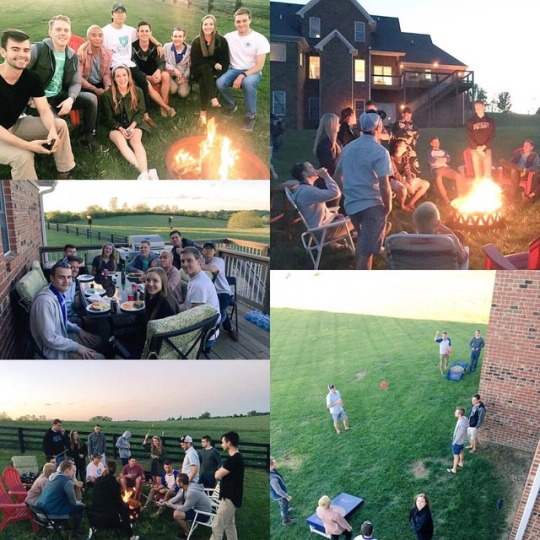
End of semester cookout for the Awesome Inc interns! Going to miss this batch of rainmakers who spent the last 4 months making Lexington a better place. #TeamAlpha
0 notes
Text
Trash Cans, Filtered Water, and Startups.
by Keith McMunn
3 Quick Lessons for Startup Founders from Scott Weiss’ Corporate Career
He looked about as comfortable in front of a crowd of people as you might expect a CEO to look. In his blue jeans and button down shirt, Scott Weiss adjusted his microphone as he prepared to tell a room of young entrepreneurs about the journey of his corporate career and how it helps him as the CEO of Ocean Accelerator, a nationally-recognized program designed to help startups grow.
“After graduating from Indiana University and getting a Masters at the University of Michigan, I worked for a little company called Procter and Gamble for many years,” Weiss told the room.
Have the humility to listen and the boldness to learn.
The reason Weiss started working at P&G? Well, it all goes back to one evening in the early days of his marriage. He and his wife were struggling for direction in their careers and to find the money to pay rent. This particular evening she found an envelope that he had thrown in the garbage. The return address was from Procter and Gamble, a company neither of them were familiar with. After opening the envelope, Weiss’ wife found that he was being offered a Marketing internship, an industry he had no prior experience with. The offer was left-field enough to prompt him to throw it back in the garbage.
With some strong encouragement from his wife, Weiss stepped into the internship opportunity at P&G. The internship would lead to a full-time offer and eventually many successful years of working alongside major brands like Tide and Brita.
Show what better looks like.
“Brita is an amazing story,” Weiss told us.
Weiss and his team celebrated tremendous success from the introduction of Brita’s personal water-filtration system. The celebration was short-lived, however. They noticed that first-time Brita users came in droves but didn’t seem to return. In other words, many people were excited to try the product but unconvinced to purchase replacement filters for future use.
“I searched everywhere for the problem. I spent months traveling and interviewing people asking why they didn’t feel compelled to continue filtering their water after their initial experiences with the product.”
The resounding answer became, “Scott, the water goes in clear and comes out clear. How the heck am I supposed to believe it’s working?”
“That was it,” he thought. “Even if it’s nasty to look at, customers want to see the product working.”
Realize your relationships.
Fortunately, Weiss remembered building a relationship with a Japanese company that specialized in non-fibrous kidney dialysis filters earlier in his career.
Though years had passed and the connection seemed like a stretch, Weiss was able to approach them, and the result was the implementation of something similar to their design on the Brita. This allowed water-drinkers to see a collection of dirt and deposits at the top of their Brita while water continued through the filtration process. With the new feature, first-time Brita buyers started returning enthusiastically, and sales regained their strength.
0 notes
Text
How We Scaled a Startup from 0 Organic Traffic to 100,000 Visitors/Mo (In About One Year)
BY TYLER HAKES
About two years ago, I was tapped for an amazing opportunity.
My friends at College Raptor had just raised a Series A round for their incredible college matching technology. And the CEO asked me to help them figure out how to make it scale.
It was a consumer platform, offered for free, with the main objective being to scale traffic and drive user growth.
I was pumped.
I was ready.
Actually, I was terrified.
I had never done this before.
I had worked in marketing for my entire career and helped a lot of different companies grow their traffic and sales. But I never had to start at 0 and figure out how to get to a million.
The climb seemed daunting.
I knew that content marketing was super effective at growing and scaling a website’s traffic. I’d done that in the past and I knew it worked–somehow.
But, like a lot of people, my approach to content marketing up to this point was basically just to “blog and pray.” I knew that creating content could drive a lot of high-value traffic and generate leads and sales, but I didn’t really know how to track, measure, or control that growth in any meaningful way.
With such a big target, I had to figure out what was working for everyone else and put together a plan that we could measure and rely upon.
“Blog and pray” wasn’t going to be a good approach when I had to talk to the board of directors and investors.
We needed a plan and we needed results.
So, I started reading–a lot.
I found so many incredible resources on the web that taught me everything from how to do really in-depth keyword research to how to use competitive analysis to get to great content more quickly.
I was introduced to the Skyscraper Technique and learned about the absolute necessity of manual outreach and link building.
Together, these articles became my base of knowledge which I used to form the strategy that we would go on to use at College Raptor.

And that strategy turned out to be incredibly effective.
Just over one year after launching, we had generated well over a million visitors to the website and were bringing in over 100,000 organic sessions per month. And still growing.

In this case study, I’m going to tell you exactly how we did it.
I won’t rehash all of the specific tactical steps about how to do keyword research or send outreach emails–these have been thoroughly covered by a number of other sources.
Instead, I’ll focus on the big picture.
I’ll walk you through the strategy that we used to achieve these results and the logic behind why it works.
I’ll also share some key transition points that occur and help you really hit hockey-stick growth as well as a few lessons learned along the way and what we could have done differently to get even better results.
Let’s get into it.
Assumptions and Objectives
When we started this journey, we knew a few things to be true about what we were trying to accomplish.
I’ll call these our assumptions:
Much of our audience was using search to find information related to the college search, admissions, and financial aid process
In order to generate search traffic, we needed both content and domain authority (backlinks)
Our audience was also using social media to find information on colleges
With these assumptions in mind, we knew that our strategy had to meet our needs for reaching our target audience.
Here were our stated objectives:
Create content that attracts relevant search traffic from our target audience (college-bound students, their parents, etc)
Generate links to the website to help us improve our rankings and search visibility
Gain traction and authority in the space, grow our brand presence through social
One of the biggest realizations for me seems pretty obvious in retrospect, but at the time it felt like as huge revelation. And it became the basis for much of our strategy moving forward.
Here it is: Each piece of content doesn’t have to meet all 3 objectives.
Obvious, right?
It seems like it now.
But at the time, I was so focused on figuring out how to check all the boxes that it didn’t immediately dawn on me that each piece of content we produced could meet just one objective and that together they would generate the same outcome.
I think a lot of companies get stuck right on this point.
They understand the intrinsic roles of content, but when it comes time to actually creating it and coming up with topics, they get stuck because they can’t think of any topics that serve every single purpose.

The answer is: You probably don’t!
And this realization became the basis for our strategy.
Sure, sometimes you nail all of these objectives. Every once in awhile, you land on the perfect piece of content that feels like it fires on all cylinders. But most of the long-term growth and planning shouldn’t be spent wracking your brain for this single, golden unicorn.
Instead, break it down.
Rather than expecting every piece of content to accomplish everything, create three separate pieces of content, each one serving a purpose within the bigger strategy.
So that’s what we did.
The Trifecta: Our Content Marketing Strategy
Here’s how our content marketing strategy was structured:

I call this our “Trifecta Strategy” because it has three basic components.
Here’s how we broke down each piece:
1. Evergreen content
This content was built for search. It was topical and keyword-focused.
Think of it like the meat and potatoes of the site. It answered questions like, “what’s a good ACT score?,” or, “what do colleges look for from students who apply?”
We knew that the people searching for these topics were our target market. We wanted them to find the answer with us so that we could then encourage them to check out the product we had to offer.
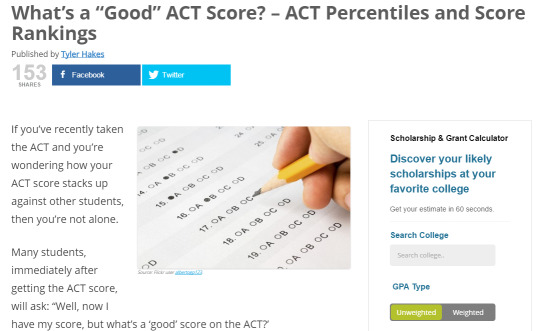
But this stuff wasn’t super sexy.
Not every post is bound for viral greatness or worthy of a million backlinks. And that’s okay.
In many cases, we barely even promoted this content–if at all. We let Google do all the heavy lifting and generate traffic over time.
By building out a huge library of this kind of topical, focused, evergreen content, we were able to cast a wide net–bringing in students and parents who were at different stages in the college search and admissions process.
2. Social-viral content
This content was designed specifically to play well within our target demographic market on social media. It was created to generate likes, shares, and traffic.
It didn’t have to be super informative. It didn’t have to be keyword optimized or meaty enough to get links.
Think like Buzzfeed.
“13 Owl Photos that Look Like Celebrities,” probably doesn’t get a lot of search traffic or earn a bunch of links.
But it goes gangbusters on Facebook.
And that drives a ton of traffic and creates brand awareness.
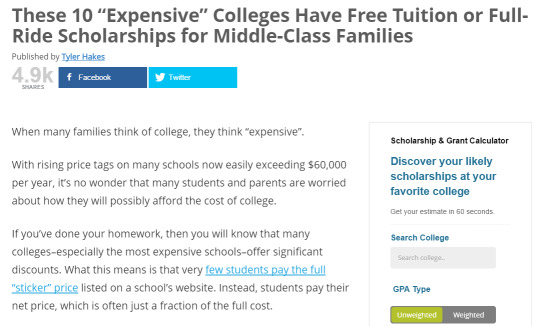
Using elements of surprise, fun, or intrigue make content go viral–but that’s an entire post unto itself.
We used social-viral content as a way to get our target market familiar with our site, to build awareness, and to start to earn trust.
You might also use this kind of content in a more traditional funnel to start to qualify prospects. You could use social-viral content to generate traffic and then use retargeting or other tactics to convert those visitors into leads.
3. Link-building content
Last, but certainly not least, we needed links to our site in order to put the evergreen content to work. Without strong domain authority, all of those articles were just lost out in the sea of Google results, probably somewhere around page 20.
By creating separate content assets that were specifically aimed at earning links, we were able to “raise the ship,” providing authority to our entire domain and raising the Google ranking of all of our pages.
This kind of content requires you to often times take off your marketing hat for a minute.
Forget about your target audience.
Instead, think about other sites, writers, or publishers.
What kind of content do they link to?
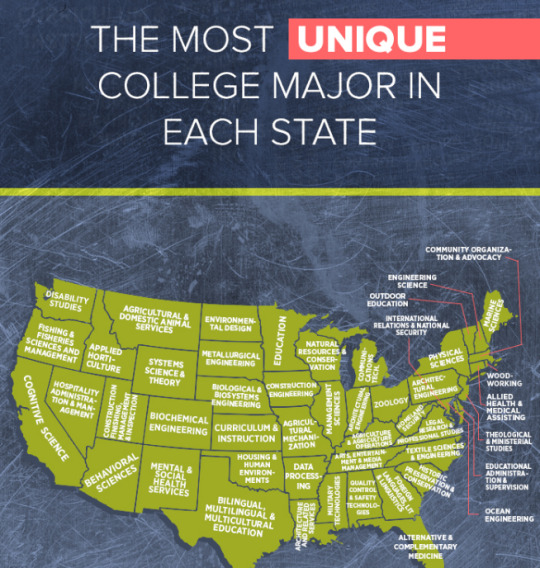
If you study this, you’ll realize that the kind of content that earns links from reputable websites is often not your run-of-the-mill blog post. It’s an engaging graphic, a new study, or an especially valuable resource.
But it’s also not as easy as simply publishing great content and waiting around for links. You need to do promotion and outreach to get the content in front of the right people. And that’s what we did.
For every piece of link-building content that we created, we spent about twice as much time doing research, compiling contacts, and doing email outreach.
Now you may be thinking that this Trifecta Strategy means you’ll have to create three times as much content. But that’s not really true. You don’t need 1,000 articles to generate 1,000 links–you only need one great resource with the right promotional strategy.
This is why the Trifecta Strategy is so effective.
It’s about creating a strategic mix of content, with each piece serving a purpose. It’s about making every piece of content work as hard as possible.
In our case, we did end up producing a lot of content in order to achieve the end result–because our addressable market was huge and there are a lot of different topics to cover. But in a smaller market, this strategy may only mean having a few really strong, product-focused landing pages that are propped up by content that’s used to earn links.
Either way, the main point remains true: Your content should work together to achieve the stated objectives. Each piece should have a purpose.
But each piece doesn’t have to serve every purpose.
Note: If this were a B2B company or you wanted to generate leads or email subs, we would also add content assets that are designed to generate leads like white papers, ebooks, email courses, etc. That would make it a “Quadfecta,” I suppose.
Using Public Data to Score Early Wins
One of the recurring things we noticed when studying different kinds of content was that most of the companies that really crushed it at building links were using data to do so.
Interesting studies, analysis, or maps–they’re everywhere. We all love a nice graphic or a data visualization. And unexpected facts and figures make for sexy headlines.
So, we set out to try to capture a piece of that success for ourselves.
One of our early successes was so simple, it seems crazy in retrospect.
We spent a few days coming up with ideas and putting together a piece of content–a nice infographic, backed by some data. Then we put together an outreach plan where we targeted news media and bloggers who we thought would be interested in what we had found.
We hit publish and sent out some basic outreach emails sharing the content with the writers we identified.
And we waited.
Was this going to work?
It was really our first attempt to grab some big attention and build links. We weren’t sure what the expect.
But just a few minutes after we sent out our emails, we got a big break.
I got this email:

Holy shit.
We got picked up by the Washington Post.
But from there, things really took off.
Once the post went up on WaPo, our content got picked up by dozens of outlets.
The Houston Chronicle in Texas. The Deseret News in Utah. Minnesota Public Radio. Time magazine. We found out later that the content was even cited before the U.S. Supreme Court.
So what was this groundbreaking piece of content?
What compelled all of these news outlets to take heed and post us on their website?
It was a map of the United States. With some college logos. And a bit of analysis.
Seriously, here’s the post: Where the 114th U.S. Senate Went to College.
We literally looked up the list of U.S. senators on Wikipedia and researched each one to figure out where they went to school. Then we made it into a map and did some basic analysis.
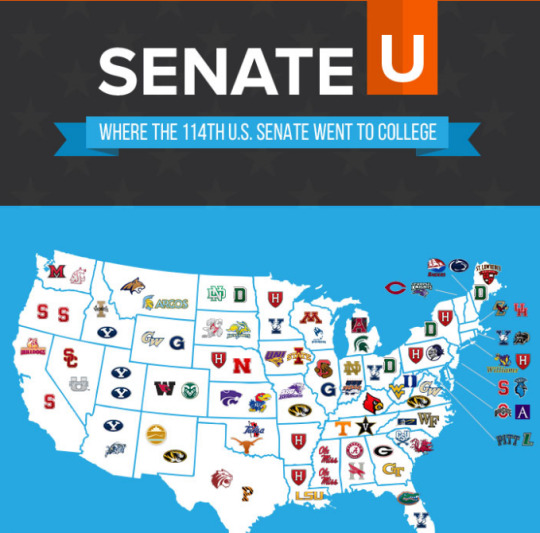
Trust me, it was not rocket science.
The biggest lesson to take away from our victory here is that you can totally use publicly available data to make cool content.
You don’t need to fund some expensive research study if you use the data that’s already out there. And there’s a ton of it.
We used other public data sources time and time again throughout the year to create rankings, infographics, maps, and other content and resources.
You can find data from a number of sources, but here are some ideas of where to look:
Public/government databases (we used IPEDS data extensively)
Manual research (like our data on the senators)
Google trends/keyword data (regional interests, trends over time, etc)
Published research and reports from academic journals
Trade publications and industry studies
Facebook advertising/page data
All of this data is out there–and it’s free.
The key to using it is to find new and interesting ways to approach the data. Take something that exists in the world and make it better, sexier, or easier to understand.
You can use this data to create things like:
Static infographics or data visualizations
Interactive data tools or resources
Maps, charts, and graphs
Ratings or rankings
Layered research based on data from multiple sources
Once you have something cool and interesting, then it’s just a matter of showing it to the right people. Email it to writers who cover the beat. Make it simple for them to pull it down and use it in their own stories.
Keep in mind that this content doesn’t necessarily have to be created for your primary audience. It should be related to your market, for sure. But the real goal here is to get links.
Writers and publishers in your industry are your target audience, not your average user.
Our infographic wasn’t really going to appeal to a 16-18-year-old high school kid. It didn’t really help them find the right college. But it helped us get links, which helped us bring traffic to all of our content that was aimed at our main audience.
Remember, the strategy is about putting together the pieces, not trying to make every piece of content meet all of your goals at once.
Our First Viral Success & What We Learned
Early on, we saw a lot of wins like the infographic from above. Little victories here, spikes in traffic there.
But nothing compared to our first big success.
In the last week of May, we published something new and different. At the time, we honestly weren’t sure how it would go.
We knew that we wanted to go after the world of college rankings, which are big game for many major publishers. But we couldn’t compete head-to-head on a list of “Best Colleges.” We didn’t have the authority to get traction there (yet).
So, we improvised. We put our own spin on things.
And we came up with the idea to create a ranking of “Hidden Gems.” These were colleges that, according to our methodology, were being overlooked by students when compared to other colleges of similar quality.
For the sake of simplicity, let me just say that this was a different kind of college ranking.
One of the things that we got right (in retrospect) was that many of the colleges we honored were not your typical “Best Of” colleges. They were still good schools, but they generally weren’t on a list of the top 100.
Fast forward to the day of the launch.
After spending a few days compiling all of the data, creating some graphics, and putting together the final post, we clicked publish. Then we got to work on outreach.
We had a plan to promote the content and put in front of people who mattered most. We sent out hundreds of emails and messages to colleges, newspapers, counselors, and anyone else we could think of who might help us spread the word about the ranking.
I spent the better part of the day drafting and sending emails.
Then we started to see results.
We watched as traffic started to pour into the site. 10 people. 20 people. 100 people. Pretty soon we had a steady stream–hundreds of people on the site at once for hours on end.

The colleges on our list were sharing the content on their social channels and their students and alumni were sharing it from there.
We were going viral.
When the dust had settled, we had the biggest spike in traffic to date.
250,000 visitors in just one week. That’s huge.
We also generated a ton of links–many from reputable news websites and EDU domains.
From this success, we learned a lot about what factors would help push our content over the top:
1. People love sharing maps
As you may be able to tell from our first big successes, people really, really love maps. Seriously, they do. And we figured out early that we could use them effectively. I think it plays on both our sense of identity and our sense of being different from other people in the country.
We would go on to use this as a cornerstone of our link-building strategy, segmenting data geographically whenever possible.
2. Vested interest helps expand reach
We were posting about colleges and shining a spotlight on their institutions. So, by including these colleges in the actual content, they had a vested interest in promoting the piece.
In total, we had a college from every state–or a base of 50 targets for outreach.
To boot, since we took a different approach in our rankings, many of the colleges on the list were not used to receiving national accolades. These weren’t the same 50 schools that are on the U.S. News list of top colleges every single year. But they were still good institutions.
This taught us the power of vested interest. Any time our content could help promote another entity, we could work with them to expand our reach and grow our audience.
3. Self-affirmation and positive social proof encourage sharing
The effect was amplified even further because each of these colleges had an audience of alumni and current students. All of them had their own vested interest in the positive social proof of having attended a “Hidden Gem” college. So many of them shared it and helped spread it far and wide.
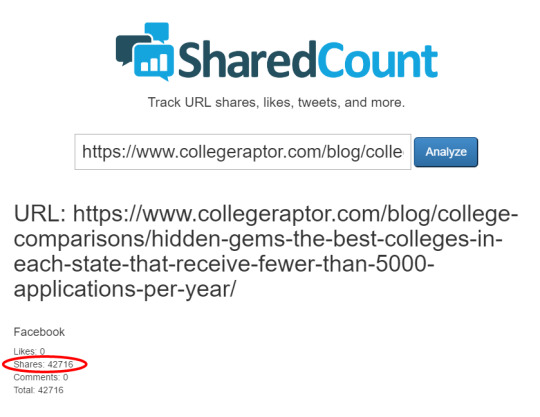
Our content ended up with tens of thousands of shares, likes, and comments. (Note: The numbers here don’t seem to be displaying likes/comments correctly, but the share count lines up with what we saw a few months after publishing the post.)
We learned that one of the keys to going viral is to create content that plays on our desire for self-affirmation. People love to share things from reputable, third-party sources that seem to confirm a belief they already have (e.g., they made a great choice by attending the college they chose.)
4. Coordinated outreach is critical
Outreach is ultimately what made this piece work.
We gathered hundreds of contacts. We wanted to make sure that someone saw it at each college. We wanted to send it to their respective local media. And we wanted other influencers to take note of a new type of college ranking that didn’t have the same 20 schools at the top.
Our team spent way more time doing outreach and follow-up to ensure the success of this piece than we did actually creating it.
That proved to be a big lesson for us moving forward.
Great content is great, but it ultimately doesn’t matter if noone sees it.
Although we had already focused on outreach, this caused us to realize the magnitude of the outreach we needed to do to achieve these kind of results.
5. Comprehensive promotional materials make it easy for people to help you
If you want people to promote your content, you need to give them everything they need to do it.
Make it so simple they can’t say no.
When we did outreach to colleges about this recognition, we didn’t just send them a link to our post.
Oh, no. We did way more than that.
We prepared a press release template. We created a visual badge. We gave them specific materials and instructions on how to promote and publicize the achievement.
And it worked.
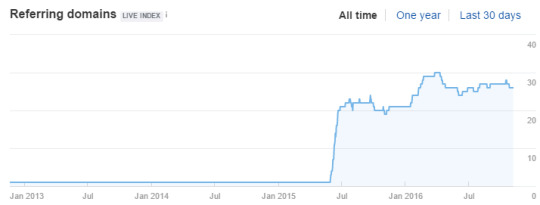
Dozens of colleges used the materials we put together and helped promote this piece, sending it viral, and generating tons of links back to our site–almost all of them from high-authority EDU domains.
Rinse & Repeat
Okay, so we had some big wins under our belt. I mean, we had just driven a quarter of a million people to our website in 7 days.
We made it. Right?
Well, not exactly. In fact, that was dead wrong.
We learned quickly that although we celebrated every win as a huge victory, the traffic quickly died down. Just as quickly as the Internet shines its light on you, it moves on to the next thing.
And that’s another big lesson to learn. Sustained growth for a website like this doesn’t come through a single flash of brilliance or a viral success. It almost never works that way.
It’s incremental. It’s slow–sometimes painfully so.
Keep in mind that what you’re doing is basically trying to assemble an airplane in mid-flight. You’re trying to create content that will rank well in search, while at the same time also earning the links that you need for that content to rank.
It’s not an overnight process.
And you will fail at times. You’ll spend too much time creating something you think is great, only to have it fall flat when it’s finally pushed out into the world. That’s okay.
The key is consistency and process.
Keep moving forward.
Hitting Explosive Growth
At this point, we were on a solid growth path. We were seeing steady increases in traffic and all of our existing content was rising in the SERPs.
We were about 8 months in and had about 150-200 linking domains.
But we didn’t set out to achieve slow and steady. We wanted big-time, hockey-stick growth.
So, we changed course.
When we got to this point, we knew we had an opportunity to really turn up the dial.
If each new piece of content that you publish lands pretty high on SERPs, then it becomes a question of how many pieces of content you can load up–how many unique search terms you can rank for.
This is because the domain authority that you’ve built helps lift each piece of content on your website.
More pages = more keywords = more traffic.
So, we slowed down our production of content aimed at generating links and social traffic and focused more on heads-down production of evergreen content targeted at relevant keywords.
We brainstormed hundreds of article ideas, digging into all of the topics related to the college search and admissions process.
We came up with content ideas by:
Looking at our competitors and identifying gaps
Doing extensive keyword research
Joining forums and communities with our audience asking questions
Sourcing questions from our existing audience
Over the course of a few months, we published about 200 articles.
This propelled us to the next level. Up until this point, we had seen a slow and steady growth in traffic.
But this step changed our trajectory.
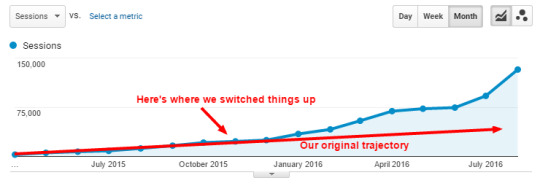
Now, we had over 300 articles on the site that were all working to bring in search traffic from our target audience on a huge range of relevant topics. Our traffic started to explode. We were growing at 20%-50% per month.
This worked because we had spent the first 8 months focusing almost entirely on earning links. We had generated enough domain authority that each new piece of evergreen content was almost certain to land somewhere on the first page of Google for the target keywords.
It’s worth noting that we didn’t have to do it in this order. We could have spent the first months doing a production sprint and building out a huge catalog of content. Then we could have spent the latter half of the year building links to “raise the ship” on the content that already existed.
The order doesn’t really matter, ultimately. And the results should have been ostensibly the same.
But there can be some strategic advantages to your order of operations.
In this case, we opted to build links first and then focus on building out more content. Since College Raptor had a number of data-driven, programmatic pages, building authority early started to show results right away, even if we didn’t have a lot of search-focused content.
What I Would Have Done Differently
Looking back over this year of work, it’s obvious that we accomplished something that many companies and startups only dream of achieving.
But that doesn’t mean we did everything perfectly right.
Although we had a lot of success, this was ultimately one giant learning experience. And I learned a lot.
Here are some of the things I would do differently:
1. Work smart(er), not hard(er)
Like many others, we started out with the assumption that our content really needed to be something special–something no one had ever done before, seen before, or even dreamed of.
We spent hours wracking our brains for ways to twist or layer data to make something new.
What I know now is that you don’t need to try to reinvent the wheel every time. There are easy wins to be had by simply looking for what’s been done and making incremental improvements or changes. In some cases, you can even take the exact same premise and put your own spin on it or create your own version. If you’re after links, you might simply do outreach to a different audience.
This doesn’t give you a pass to be lazy. You still need to create great content.
But you can be smart about it and learn from the experience of others.
2. Repurpose more
Another way to make better use of time and resources is to build repurposing into the core of your strategy.
This can take a lot of forms. It may mean creating a series of graphics that work as a big, long infographic and also can be broken down into smaller graphics that are used in a series of text-based posts. It might mean collecting a series of content that’s already published on your site and packaging it up into something “new.”
But, repurposing is a great way to get extra mileage from the work you’ve already done.
Look for opportunities to tie things together or use your assets in different ways or for different audiences.
Remember that just because you’ve read something on your site doesn’t mean everyone has. So there’s no shame in giving it a second, third, or fourth life.
3. Curate content where it works
It’s tempting to think that if there’s good content out there, you need to set out to make something better–bigger, sexier, more helpful.
But sometimes you should just take what’s already been given.
Notice that I didn’t use this case study to explain to details of how to craft a nice outreach letter or use a tool like Ahrefs to identify link opportunities. That’s because it’s already been done–a lot. So rather than simply rehashing what’s already been created, I just put together a collection of prerequisite resources.
In an age of so much content, sometimes the best thing you can do to add value is to simply serve as a filter.
Curate a list of the best of what’s already out there.
Many of the great content marketing and SEO experts of the world rely heavily on curating lists of other people’s content to provide value to their readers. And they can still use it to generate traffic and links.
Don’t underestimate the power of curation.
4. Focus more on design and presentation
Another thing to keep in mind is that looks matter a lot–probably more than you think.
Beyond just having a reasonably designed page, design can play a big role in the success of your outreach and link building. Many times, people won’t even read your content. They’ll skim and try to pick up some of the key points.
They’re busy and they just want to know, “is this a valuable resource of just some spammy junk?”
Having a page with a nice design can set their mind at ease quickly. A wall of text may contain the same information, but it doesn’t feel quite as nice as a well-designed guide with clear bullet points, section headings, and useful graphics.
Content is ultimately only useful it’s also usable.
Using the “Trifecta Strategy”
I wanted to share this experience not just to brag about the numbers (although they’re pretty impressive, if I do say so myself). But, because what we learned through this process was that this model–this content marketing strategy–could be applied to almost any business.
Let me be the first to say that it’s not easy.
In fact, it’s damn hard. It takes a ton of work.
But with focus and the right team, this same framework can be applied in nearly any industry–the three (or four) content types are universal.
What changes is the strategic mix of content that you need in order to achieve results.
Here are some tips for adapting this strategy:
1. Plan for SEO from the beginning
This strategy was ultimately so effective at generating huge amounts of search traffic because we went wide and shallow in terms of SEO. We had a huge number of pages related to a broad range of college topics.
If your business relies on ranking highly for a few specific keywords–like, say, an eCommerce store, for example–then your strategy will likely be different. Evergreen content may not be valuable in terms of bringing in traffic that actually converts. So your strategy may focus almost entirely on building links and driving social traffic.
Whatever the case, you must consider the SEO landscape of your industry and then adapt the strategy to help you compete there and achieve your goals.
2. Set a benchmark (the 7% rule)
The general rule for achieving the all-mighty hockey stick is that you should aim for 7% growth, week over week.
The same benchmark generally applies here. We used 7% weekly growth in organic traffic as a goal and it gave us something to chase after and also a way to project what our growth would look like into the future.
You probably won’t hit 7% every week, but if you’re seeing about 7% on average, then you’re probably in good shape.
3. Stay strategic
One of the reasons so many people fail at content marketing is because they lose sight of their strategy.
Instead of focusing on results, they just worry about publishing content–any content. Just to meet some arbitrary schedule or quota. But this is ridiculous.
Content takes time, money, and effort. And if you’re not using it strategically–if you’re blogging just to blog–then it’s simply an expense that isn’t generating a return.
Do what you need to focus on the strategy and make sure that every piece of content that you create and publish is being put to use as an asset. Everything you create should be focused on one of the core objectives of your strategy.
If you can’t immediately say what the purpose of a post would be, then scrap it.
Essential Reading
As I mentioned at the beginning of this post, most of our strategy was built on the teachings of many SEO and content marketing experts who generously share their time and knowledge.
People like Neil Patel, Noah Kagan, Robbie Richards, and Brian Dean were all hugely helpful in teaching me some of the fundamental laws of scaling traffic.
Since I didn’t have the opportunity here to rehash all of the specific strategies and tactics that I learned from them, I’ve packaged them up into a collection of essential ideas, strategies, and tactics for anyone who wants to apply this strategy or achieve similar results.
Grab a free copy of this collection of essential reading, tools, and know-how by email.

0 notes
Text
How do I fund my idea?
by Nick Such

I frequently get this question from aspiring entrepreneurs. I think it is an innocent question, but one which is misguided. Here’s the bubble burster: ideas on their own have little to no value. So while you may be able to find a donation, you do not yet have something which is a good fit for investment capital. For an entrepreneur at the idea-stage, “How do I fund my idea?” is the wrong question. There’s a better question you should be asking: “How do I make my idea worth funding?”
Commercial value is created when ideas meet execution. Scientists may make brilliant discoveries in the lab, but we consumers can’t buy these novel ideas until they’re “commercialized”. When an aspiring entrepreneur comes to me looking to fund his or her idea, it’s often because of the perceived need for capital in order for execution to occur. Yes, it often takes money to develop software or manufacture a product. As someone with a college degree in engineering, I often think that the first step of execution is product development. However, it turns out that you can create value without writing a single line of code or fabricating a widget.

In less than 3 days, my friends made $1000 in profit selling subscriptions to a beef jerky delivery service. They did this without owning any inventory. They had an idea (“It would be cool if you could get high-quality beef jerky delivered to your door each month”), which wasn’t even an original idea, and they created value not by building a product, but by validating demand for that product. They made phone calls, sent Facebook messages and emails, and even contacted leads via Tinder. In the case of Awesome Jerky, people were not just vaguely interested in future beef jerky deliveries, but they were specifically interested enough to pre-pay for the service. Then, with cash in hand, the Awesome Jerky team bought their first selection of beef jerky and distributed it to their customers. The started with an idea, then validated it, made sales, and finally built a system to deliver product to their customers.
Now, I’ll admit, sometimes you do need a product before you can sell it. In a subscription retail model like Awesome Jerky, customers know they like they product, it was just a new method of purchasing cured meats. For a brand new product, how can your customer even know what it is? The answer is not a well-polished product, but a Minimum Viable Product. The definition of “minimum viable” depends on your product. Minimum Viable Self-Driving Automobile is in a different class from Minimum Viable Booster Seat.

This reminds me of the story of Foodshoppr, an idea that I helped turn into a business in 2013. My friend Mark is a dad, and with some unique parental insight, he came up with a brilliant idea. For me, as a single guy at the time, grocery shopping was easy: walk into store, grab small basket, shove the same 10–15 items into it as always, pay at self-checkout, go home. There were few surprises, variability, or challenges in my grocery shopping routine. It was quick and easy. Mark’s experience, he and his wife with three kids in-tow, was much different. A typical Sunday afternoon grocery trip for him involved one child crying loudly, another trying to run away, and the remaining kiddo tossing sugary cereals into the cart. This two-hour endeavor was not seldom fun, and barely productive, for Mark and his family. He wanted to find a way to make grocery shopping better for families.
Mark reflected on the ways to improve grocery shopping. His issue was not the convenience of the location of the stores. He had no problem loading the kids up in the car, or even coming home and unloading the bags of groceries from his trunk. His beef was with the store experience: going inside, wandering the aisles, and waiting in the checkout lines — all while managing a small flock of children. So, Mark’s idea was to shop and pay from home, just going to the shore to pick up pre-bagged groceries. To do this, he decided to turn his iPad into a visual shopping device. Since Mark is not a software developer, he came to me and my friends to make that happen.
When you’re an engineer, it’s easy to think the first step in turning an idea into reality is to develop your product. For a software product, this meant writing code. After a few weeks of wireframes, crisp mockups, and iOS app prototypes, we had made progress, but weren’t ready to help people buy groceries. Then, my friend and Awesome Inc co-founder Luke Murray asked me an important question: “What if you had to finish it tonight?” Luke challenged me to build the entire product in under two hours. What happened from this creative constraint has defined how I’ve approached ideas ever since.
We built Foodshoppr, running the service for three months for a few dozen paying customers, without writing a single line of code. Instead, we cobbled together a bunch of off-the-shelf systems and services into our “product”:
Domain from GoDaddy
Google Form to collect customer info
Text Messaging to schedule pickups
Google Calendar to internally keep track of schedule
An existing grocery list sharing app to select food items
Square to process credit card payments
Google Sheets to internally keep track of payments
To build this as an iOS app would have taken months of time, and well over $10,000 if we were paying someone else to develop it. Instead, it took under two hours, and no up-front cash. To your customers, your product is nothing more than an experience. They don’t notice servers, app version numbers, or the hours you took designing button shapes and writing code. They just want to use it to gain value. So figure out whatever it takes for your idea to start providing value to your customers, a process called Customer Development, and do that first.
If you have an idea, my team at Awesome Inc would like to help point you in the right direction. We’re not going to fund your idea, but we can help you create value by taking the first few (often free) steps in validating and executing your idea. Fill out the I Have An Idea form to get started.
0 notes